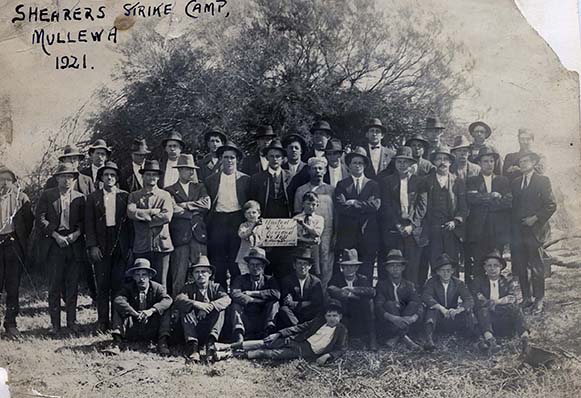Shearers
Shearers
The Queensland Shearers' Union (QSU) was formed in January 1887 to help combat pastoralists' attempts to reduce the shearing rate. By the time the union had registered under the Queensland Trade Union Act in August 1888 it had well over nine hundred members, and a year later, close to three thousand.
The union was profoundly tested in the Great Shearers’ Strike of 1891, which is considered to be one of the earliest and most significant industrial disputes in Australian history. The strike resulted from a major dispute between Queensland pastoralists and shearers. Pastoralists in Central and Western Queensland claimed economic instability overseas was leading to falling prices for wool. In response to this, they wanted to exercise a ‘freedom of contract’ which would result in severe wage reductions for shearers. Many shearers refused to sign these contracts, stating that it would erode their right to a set fair wage. With no compromise forthcoming, shearers went on strike and withheld their labour, crippling the industry.
The pastoralists were supported by the conservative colonial government, who sent over 1,000 soldiers and special constables to the area, along with “scab” or strike-breaker labourers who were sent to the area with military escorts to prevent clashes with unionised striking shearers.
A strike camp was established at Barcaldine and within a few months there were approximately 4,500 shearers camped in the area, with regular strike meetings held and tensions running high. The government response to this was to arrest the strike leaders and in May 1891, 14 men were sentenced to three years hard labour for their role in the strike.
With the arrival of additional non-union shearers and the removal of the strike leaders, the determination to continue the strike waned and in June 1891, the union declared the strike over. However, the union decided to pursue action through election and in a by-election in Barcoo in 1892, shearer Tommy Ryan ran against the conservative’s William Campbell and won, becoming the first Labor parliamentarian in Queensland. In 1899, Queensland went on to elect the world’s first Labor Government.
The QSU was constantly at odds with the larger Amalgamated Shearers' Union of Australasia and rejected amalgamation attempts from that union only to accept by plebiscite an amalgamation with the Queensland Labourers' Union in October 1891 to form the Amalgamated Workers' Union of Queensland, which it did in April 1892.
Outside of Queensland, the Amalgamated Shearers' Union of Australia (ASU) was formed in 1887 by the amalgamation of the Australian Shearers' Union, the Bourke Shearers' Union and the Wagga Shearers' Union. It quickly grew to represent shearers across New South Wales, Victoria and South Australia. However the ASU was constantly fighting for survival through strikes, economic depression and severe drought which savaged the wool industry and further impeded its progress.
By 1894 the ASU, in order to maintain a strong union front in the rural sector, was forced to merge with other rural-based unions to form the Australian Workers' Union. The Australian Workers' Union grew throughout the colonies to become one of the largest, most influential unions in Australia.
The Waughs - Bushmen and Gentlemen
The Waugh Family were a well-known pastoral family led by John Waugh Senior (1836-1922), a Scotsman who migrated to Victoria in 1854.
John quickly found work, including at Boonoke Station and Yanco Station in the New South Wales Riverina Region. By the late 1860s he was managing Burrabogie Station, near Hay, NSW. In 1872 he became co-owner of Kooba Station near Griffith, NSW, before purchasing Clare Station at Balranald, NSW, along with his brother William and W.E. Stanbridge. Noted as a very good judge of sheep and cattle, he eventually retired in 1912.
John Waugh Junior was one of five children of John Waugh Senior. Like his father, he was a well-respected pastoralist and noted as having “few equals as a judge of stock”. Born at Yanco Station in 1865, after finishing school at Geelong College, he went to work at Clare Station, before being entrusted by his father with the management of the property. He eventually retired in 1929 and lived in Sydney until his death in 1945.
Tom Tansey
Timothy (Tom) Tansey was born in Mount Gambier, South Australia on 20 October 1861.
At age 11 he was sent to work as an assistant to a teamster working bullock teams in Victoria carting wool, salt, grain and hides. He then worked as a roustabout in a team shearing in Western Victoria, which led him to employment as a carpenter’s mate at Worrock Station.
He worked as a seasonal shearer and also at Worrock where he met his wife Louisa Chester who was a school teacher and lady’s maid.
In 1898 Tom and his brother Hubert started their farm at Chetwynd on the Glenelg River, Victoria. Tom and Louisa married in 1900 and had three children - Ellen, John and Hubert.
By 1916, after the death of his brother Hubert and years of drought, Tom lost all his stock and savings.
In 1919 he worked as a labourer in Melbourne and took on shearing work and by 1926 Tom was shearing fulltime.
In 1930 he changed to blade shearing as he worked on a round of New South Wales, Victoria and Tasmania shearing stud stock.
He retired in 1936 aged 75 and died on 4 June 1941 aged 80.
The Noel Butlin Archives Centre holds records of the Queensland Shearers’ Union as well as related records within deposits of the Australian Workers’ Union, Amalgamated Workers’ Union, Livestock and Grain Producers’ Association, Australian Council of Trade Unions and various pastoral stations covering the 1800s and 1900s.
References
Huf L 2010, Queensland Historical Atlas – Great Shearers’ Strike of 1891, <http://www.qhatlas.com.au/content/great-shearers%E2%80%99-strike-1891>
The Barcaldine Story – The Shearers’ Strike 1891 n.d., <https://barcaldine-peopleplacesthings.org/origin/shearers-strikes/1891-2/>













